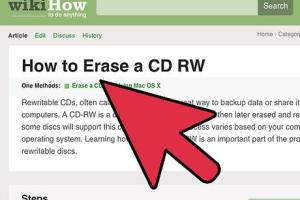Ultimate Guide on How to Effectively Destroy a CD or DVD

-
Quick Links:
- Introduction
- Why Destroy CDs and DVDs?
- Methods of Destruction
- Step-by-Step Guide to Destroying CDs and DVDs
- Case Studies and Expert Insights
- Environmental Considerations
- FAQs
Introduction
In a digital age where data privacy is paramount, knowing how to destroy CDs and DVDs effectively is essential. These optical discs often contain sensitive information that, if not disposed of properly, could lead to data breaches. This comprehensive guide will explore why destroying these media is important, the various methods available, and provide a thorough step-by-step process to ensure your data is irretrievable.
Why Destroy CDs and DVDs?
As technology evolves, many people find themselves with stacks of old CDs and DVDs containing personal, financial, or proprietary information. Here are some compelling reasons for their destruction:
- Data Privacy: CDs and DVDs can be easily read by anyone with the right equipment. Destroying them protects your personal information.
- Prevent Identity Theft: Old discs can contain sensitive data such as social security numbers, financial details, and more.
- Compliance with Regulations: Many industries have regulations requiring the destruction of data once it is no longer needed.
Methods of Destruction
There are numerous methods for destroying CDs and DVDs, each with its pros and cons. Below, we explore the most common techniques.
Physical Destruction
Physical destruction is the most straightforward way to ensure that your CDs and DVDs are unusable. Here are some popular methods:
- Shredding: Using a CD shredder can efficiently cut up the disc into tiny pieces, making it impossible to read.
- Drilling: Drilling holes through the disc can disrupt its data layers, rendering it unreadable.
- Breaking: Simply snapping the disc can work, but it may not ensure complete data destruction.
Chemical Destruction
Chemical methods involve using substances that can degrade the materials in CDs and DVDs. Common chemicals include:
- Acetone: Soaking the discs in acetone can break down the plastic and reflective layer.
- Bleach: A diluted bleach solution can also damage the disc's surface.
Software Methods
For those looking to wipe data from rewritable CDs and DVDs, software options are available:
- Data Wiping Software: Tools like DBAN (Darik's Boot and Nuke) can securely erase data from discs.
- File Shredding Software: Programs that overwrite data multiple times can ensure that it cannot be recovered.
Step-by-Step Guide to Destroying CDs and DVDs
Follow this guide to effectively destroy your CDs and DVDs:
- Gather Materials: Collect your CDs, DVDs, and any tools you plan to use (shredder, drill, or chemicals).
- Choose Your Method: Decide whether you'll use physical, chemical, or software methods based on your needs.
- Ensure Safety: If using chemicals, do so in a well-ventilated area and wear protective gear.
- Execute the Method: Follow through with your chosen destruction process.
- Dispose of Remnants Properly: Ensure any remaining pieces are disposed of according to local waste regulations.
Case Studies and Expert Insights
To validate the effectiveness of these methods, let’s look at some case studies:
Case Study 1: Corporate Data Security
ABC Corp had a data breach due to improperly disposed CD drives. After this incident, they implemented a strict CD shredding policy, resulting in zero data leaks in the following year.
Expert Insight
According to data security expert Jane Doe, “Physical destruction is the most reliable way to eliminate data risks associated with optical discs.”
Environmental Considerations
It’s important to consider the environmental impact of destroying CDs and DVDs. Here are some eco-friendly disposal strategies:
- Recycling: Many recycling centers accept CDs and DVDs. Look for local facilities.
- Eco-Friendly Shredders: Use shredders that can turn discs into recyclable material.
FAQs
1. Can I just throw away my CDs and DVDs?
No, throwing away CDs and DVDs without destroying them can lead to data theft. Always use a secure destruction method.
2. What is the safest method to destroy a CD?
The safest method is shredding, as it physically destroys the disc into unrecognizable bits.
3. Are there any chemicals that can dissolve CDs?
Yes, acetone and bleach are effective in breaking down the materials in CDs.
4. Can I use a regular paper shredder for CDs?
No, regular paper shredders are not designed for CDs. Use a shredder specifically made for optical media.
5. How do I know if my data is truly destroyed?
After destruction, verify that the discs are unreadable, and consider using software to confirm data removal.
6. What should I do with the pieces after shredding?
Dispose of the pieces according to local waste regulations or recycle them if possible.
7. Is there a way to destroy data on rewritable discs?
Yes, you can use data wiping software or physically destroy the disc.
8. How long does it take to destroy a CD or DVD?
Physical methods can take seconds, while chemical methods may take longer due to soaking time.
9. Are there any DIY methods to destroy CDs at home?
Yes, you can drill holes in the discs or use a hammer to break them into pieces.
10. Can I donate old CDs and DVDs?
Only donate if you are sure they don’t contain sensitive information. Otherwise, use secure destruction methods.
Random Reads
- Opening dicom file free viewers photoshop
- Open windows explorer
- Open executable files mac
- Open idx files
- Mastering class width calculation
- Mastering chrome viewing tabs
- Ultimate guide changing globe home wifi password
- How to search old emails in gmail
- How to search messages on whatsapp
- Mastering gmail on iphone